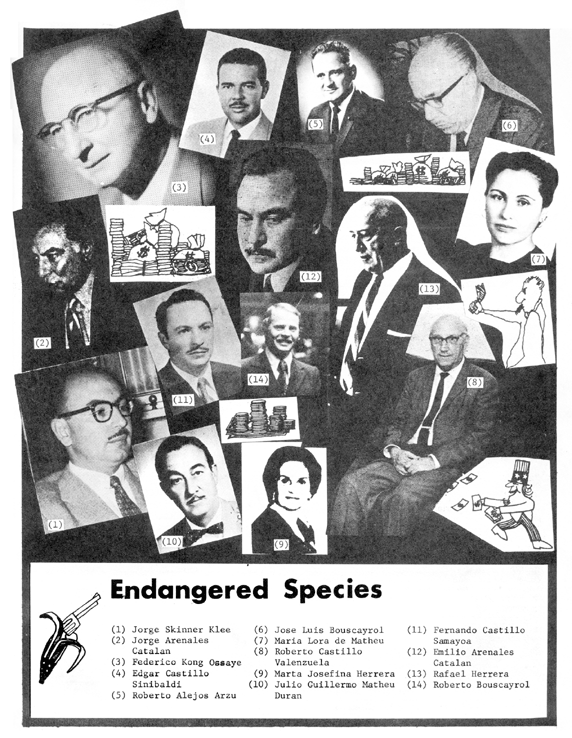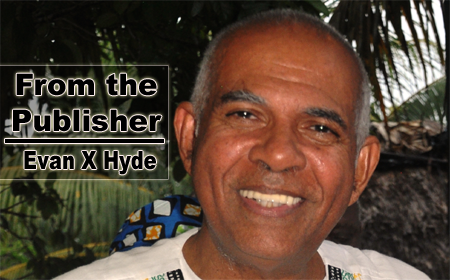Blasé Bonpane was a Maryknoll priest working in Guatemala at a university student center. In late 1967, together with several other Maryknoll priests and nuns, he was forced to leave Guatemala on charges of collaborating with the guerrillas.

In the following statement, Bonpane explains the conditions that led him to become involved in the struggle.
“The so-called extremist right is directed and approved of by the army. I recall a visit to the town of Gualan in the department of Zacapa. I went there with a team of students from the National University to establish a youth center. A week after the group was organized, its president received a death warning from the Mano Blanca (White Hand).
“I went alone to visit the head of the Mano Blanca and asked him why he was going to kill this lad. At first he denied sending the letter, but after a bit of discussion with him and his first assistant, the assistant said, ‘Well, I know he’s a Communist and so we’re going to kill him.’
“‘How do you know?’ I asked
“He said, ‘I know he’s a Communist because I heard him say he would give his life for the poor.’
“With such a definition of communism, we find many names in the Communist ranks, including Jesus Christ’s.”
– pg. 187, GUATEMALA, by the North American Congress on Latin America, 1974, originally published in the Washington Post of February 4, 1968.
Over the past four decades and more, there have been several occasions on which I sought to give our readers a glimpse of the most powerful families which comprise the Guatemalan oligarchy. I used as my source material on these previous occasions a 1974 publication, entitled GUATEMALA, by a group which called itself the North American Congress on Latin America (NACLA).
In 1974, the publication sold for $5 US, but today my personal copy, tattered and falling part, is priceless to me. I have no recollection of how it came into my possession. One of the most important sections of the book is called “Guatemala’s Bourgeoisie: The Top 20 Families.”
It occurred to me that we had to reproduce some of the material in that section when, during KREM Radio/Television’s live broadcast from Guatemala City on Sunday, April 15, during Guatemala’s referendum on International Court of Justice (ICJ) arbitration for their claim to Belize, a skeptical roots Guatemalan underlined his disinterest in the referendum vote by telling his Belizean interviewers (Marisol Amaya and Ya Ya Marin Coleman) that it was only the big Guatemalan families, like the Castillos and the Arzus, who would gobble up whatever gains accrued to Guatemala from the claim. (Interestingly enough, one Alvaro Arzu, who had been a Guatemalan President, died of a heart attack last weekend at the age of 72.)
I don’t believe I have ever told you that when I began St. John’s College in 1959 at the age of 12, I distinctly remember that there was a Guatemalan in our 1-A class by the name of Herrera, which is one of the 20 Guatemalan ruling families named by the North American Congress in Latin America. The young man wore glasses, was very quiet, and looked older and bigger than most of us in 1-A.
At that time, the Jesuits at Landivar had a special program where they housed sons of the Latin American political, business, military and other elite groups, in the two buildings on the eastern side of the campus which became the original Sixth Form buildings back in 1964 when the Sixth Form became expanded and separate from the high school section. The sons of the Latin American elite who attended classes at SJC high school were called “internos”, because they lived on campus, as opposed to us Belizean “externos.” The attraction of the SJC programs for the Latin American elite was the fact that their sons, headed for power, learned English in their teenaged years.
With reference to the methodology they used to choose the top 20 Guatemalan families, the NACLA editors described the chart they produced in 1974 as “based on currently available public information on the economic, political, and social enterprises in Guatemala between 1871 and 1970. A systematic search was made of the documents in the National Archives of Guatemala dating back to the Colonial Period. The documents inspected included directories, census reports, newspapers, journals, magazines, letters, flyers, bank records, annual reports of the various government ministers, import/export lists, incorporation requests, property confiscation documents, organization membership lists and a variety of applications for concessions and exemptions.”
“A total of 165 family groupings was selected to examine in greater detail. The 20 most important families within the bourgeoisie were then selected, attempting to include families which represent various routes into and economic sectors of the ruling class. The decision to select 20 families (as opposed to 5 or 50) was arbitrary.”
The Aycinena family is the oldest of the twenty families, with their patriarchal ancestor being Juan Fermin de Aycinena, who came from Spain, migrated to Mexico in the mid-1700s and then Guatemala in the late 1750s. Juan Fermin purchased the title of Marquis from the King of Spain, becoming the only noble in Guatemalan history. The Aycinenas are the only one of the families dating back to the Colonial Period, that is, when Guatemala was ruled by the Kingdom of Spain before becoming independent in 1821.
NACLA points out that at least 12 of the 20 families are of non-Spanish foreign origin. Almost three-quarters of the families rose to prominence just prior to the start of the 20th century.
“The major bases of wealth of the 20 families appear to have been commerce and land in the 19th century, land and industry in the 1900-1943 period, and industry and finance from 1944 to the present.”
“In addition to branching into other areas of economic activity, many family groupings further consolidated their wealth and position by intermarrying with upper class families. This is most noteworthy in the case of the Castillo and Herrera families.”
In line with what the Guatemalan interviewee blurted out to KREM on April 15, it does appear to me from studying the NACLA document, that the largest and most powerful family in Guatemala is the Castillo family, whose patriarch is one Domingo Castillo, who began his business activities in the 1880s.
NACLA’s top 20 Guatemalan families are Abularach; Alejos; Arenales; Aycinena; Bouscayrol; Castillo; Cofiño; Cordon; Dorion; Granai; Herrera; Ibargüen; Kong; Matheu; Novella; Sinibaldi; Skinner Klee; Toriello; Weissenberg; and Zimeri. (Incidentally, the Skinner Klee family is of British extraction.)
NACLA points out that there were members of the 20 families who took part in the revolutionary government of Jacobo Arbenz between 1951 and 1954. These included Guillermo Toriello, who was living in exile in 1974, threatened with death by the military governments; the lawyer Julio Carney Herrera, assassinated in 1970 by the Carlos Arana Osorio government; and several more.
In conclusion, we provide a couple examples of the incidents of terror sanctioned by the Guatemalan ruling class. In 1966, on the eve of the election, the Enrique Peralta Azurdia government arrested 28 leading Communists and Communist sympathizers. They “disappeared,” and it was later learned that they had been assassinated and their bodies dumped in the ocean. In September 1972, 8 leading Communists “disappeared” and have never been found. Despite government denials, nearly all observers in Guatemala and internationally hold the Arana Osorio government responsible, and some police have even acknowledged their role.

